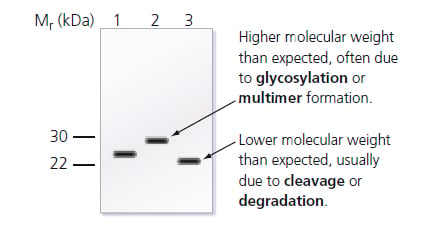Chapter 1: Why Use a Western Blot?

- On This Page
- Why use a western blot?
Overview
Western blotting is an extremely powerful technique, despite its overall simplicity, because it provides additional information not readily gathered from other key immunological laboratory techniques. Since proteins are separated by size during the gel electrophoresis stage, and then detected by a specifically directed antibody, the procedure essentially confirms the identity of a target protein.
Furthermore, when data does not match expectations, there may be clues as to what should be investigated to determine the reason . Is the band of lower or higher molecular weight than expected? Is there a single band, or are there several bands? A smaller than expected band could indicate that the protein has been cleaved or is degraded.
Conversely, when bands are seen at higher levels than expected, this may indicate an actual increase in mass due to glycosylation or multimer formation . Alternate splicing may also cause unexpected size variations, as may the particular combination of charged amino acids found in the protein.

Lane 1: Target protein band at the expected molecular weight . Lanes 2 & 3: Common alterations that modify the molecular weight
Western blots are in wide use across a broad range of scientific and clinical disciplines . Their ability to clearly show the presence of a specific protein both by size and through the binding of an antibody makes them well-suited for evaluating levels of protein expression in cells, and for monitoring fractions during protein purification.
Likewise, they are helpful for comparing expression of a target protein from various tissues, or seeing how a particular protein responds to disease or drug treatment . In many cases, Western blots are used in combination with other key antibody based detection techniques, such as ELISAs or immunohistochemistry.
In these instances, Western blots provide confirmation of results both in research and diagnostic testing. For example, with HIV and prion disease, Westerns are used as a key supplemental screen since their results are less ambiguous, and quicker, than other methods.
Moving forward, Western blots continue to be of value in confirming results from antibody arrays, making them suitable for use in proteomics research. Specific results and data analysis will be addressed in further detail in Chapter 4
| Introduction to Western Blotting | Antibody Considerations for Western Blotting |


